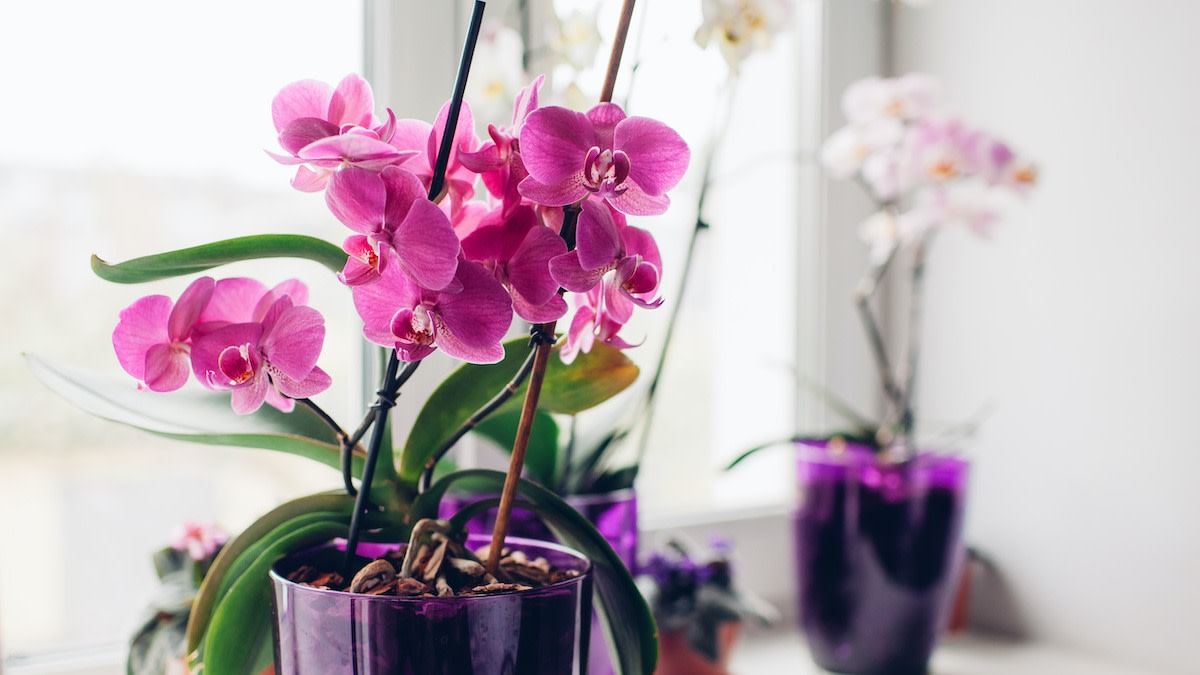Orchid Care Guide: 8 Tips for Growing Orchids
Written by MasterClass
Last updated: Jun 7, 2021 • 4 min read
Orchids are among the most popular houseplants in the world. Learn more about how to grow these elegant tropical plants.
Learn From the Best
What Is an Orchid?
Orchids (Orchidaceae) are tall flowering tropical plants with an evolved lip, three petals, and sepals surrounding it. The orchid family is robust, containing over 25,000 natural species and more than 200,000 hybrids. Orchid blossoms come in a wide range of colors, from white to orange to pink.
4 Common Types of Orchids
Here are the most common types of orchid that home gardeners grow:
- 1. Cattleya: One of the most common orchids, cattleya orchids have a ruffled appearance and a robust, vanilla-like fragrance. Cattleyas can grow up to two feet tall.
- 2. Phalaenopsis: Also called the moth orchid, phalaenopsis orchids are hardy, but they prefer high humidity and are especially sensitive to cold temperatures.
- 3. Paphiopedilum: Paphiopedilum orchids, also known as lady slippers, are among the best type for beginners to grow because they are low maintenance and thrive under most lighting conditions. This orchid type is available in a wide variety of colors and patterns.
- 4. Dendrobium: Dendrobium orchids are epiphytes that grow on other objects in the wild. They prefer high humidity, strong, indirect sunlight, and are susceptible to overwatering. Dendrobiums have delicate, light-colored flowers ranging from purple to green and mostly maintain their foliage year-round.
What Are the Best Growing Conditions for Orchids?
Orchids are one of the largest families of flowering plants globally, so there are many care variations, depending on the particular species you want to grow. However, as a general rule, here’s how to help an orchid thrive:
- 1. Well-draining pots. When you buy orchids from a nursery or gardening center, they often come in a small plastic pot that can suffocate their roots, so repotting is essential. Since orchid roots are sensitive to overwatering and dense soil—a well-draining pot is necessary to help your plant thrive. Repot your orchid plant in a terracotta pot, which helps facilitate the air circulation that the plants need to succeed. Choose a pot with at least one drainage hole at the bottom of the pot so that excess water drains out—terracotta is preferable since it’s incredibly porous.
- 2. Fast-draining soil. Avoid planting orchids in traditional potting soil or potting mix because it can smother their roots, which need consistent airflow. Instead, opt for a potting medium that’s fast-draining, coarse, and porous. A combination of fir bark, perlite, sphagnum moss or peat moss, and horticultural charcoal is a great way to keep your orchid happy.
- 3. Good air circulation. In the wild, orchid plants thrive in light breezes, which prevent excess moisture buildup and keep their roots healthy. Whenever possible, simulate this airflow for your orchids by keeping a window open in the summer or setting up an oscillating fan on a low setting.
- 4. Bright, indirect light. Orchids generally need light to thrive—usually upwards of 10 hours a day. However, their natural habitat is in tropical rainforests, so direct sunlight can burn the leaves or petals. A south-facing or east-facing window is usually the best growing area for orchids during the summer months; in darker winter months, consider investing in a bright artificial light to encourage photosynthesizing. If you have to place the plant near a west-facing window, use a sheer curtain to protect it from the direct sunlight. Your plant’s leaves will indicate whether you’re meeting its lighting requirements. Bright-green leaves mean the light levels are adequate, dark green leaves mean it’s not getting enough light, and yellowish or reddish leaves means your plant is receiving too much light.
- 5. Weekly watering. Orchids prefer drier conditions. As a general rule, water only when the top inch of the soil feels dry, usually about once a week in the growing season and even less frequently in cooler winter months. The most common mistake in orchid care is keeping the soil too wet—if the soil is too wet, your orchid will get root rot, in which the roots turn black and eventually die. Learn more about watering plants.
- 6. Moderate temperatures. Since orchids are tropical plants, they prefer warmer temperatures—daytime temperatures between 70 and 85 degrees Fahrenheit and nighttime temperatures around 60 degrees Fahrenheit. In the winter, keep them away from drafty windows.
- 7. Humid environment. Some tropical varieties of orchids are epiphytes, which, in the wild, grow in the air rather than soil. Their aerial roots extend out from the soil to absorb moisture, so to mimic their tropical environment, you’ll need to provide the plant with added humidity. Place the plant near an air humidifier during drier seasons. If you don’t have an air humidifier, you can create one by buying a small humidity tray, filling with water, layer in gravel or black pebbles to cover, then place your orchids on top. As the water evaporates, the aerial roots will absorb the added moisture.
Learn More
Grow your own garden with Ron Finley, the self-described "Gangster Gardener." Get the MasterClass Annual Membership and learn how to cultivate fresh herbs and vegetables, keep your house plants alive, and use compost to make your community—and the world—a better place.
